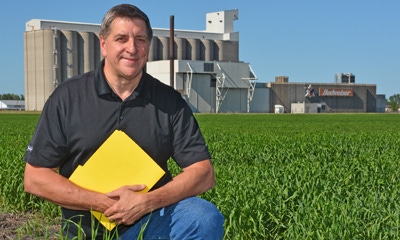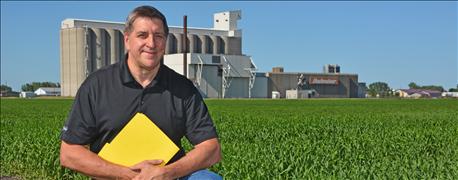
Climate change is not playing nice in its treatment of the state’s barley crop.
In northwest Minnesota, where most of the state’s barley is grown, nighttime summer temperatures have been gradually increasing over the last century, according to historical weather data.
“Warmer temperatures at night are causing us to lose yields,” says Marv Zutz, executive director of the Minnesota Barley Research and Promotion Council, based in Red Lake Falls. “The crop can’t recover at night.”
This spring, farmers who planted barley saw good establishment, but then heavy rains pelted the crop. Barley, particularly malting barley, does not do well with excessive moisture.

BRING BACK BARLEY: Alan Slater, director of U.S. barley operations at the Busch Agricultural Resources malt plant in Moorhead, kneels amid dozens of the plant’s spring barley plots. Researchers planted more than 500 plots.
Once grown for animal feed, barley now is viewed as a specialty crop, thanks to increasing demand for the malting barley desired by growing numbers of microbreweries. Zutz says that almost all barley acres are contracted for malting barley. In Minnesota, around 75,000 acres were contracted for malting barley this year, he says.
Microbrewery owners also want a specific type of barley for their beers — a two-row malting barley. Two-row barleys generally outyield six-row barleys both in the field and in malt extraction, Zutz adds.
Research shift
For decades, six-row barley was the focus of university and private plant breeding research because the variety was more suitable for the Midwest environment. That has changed due to demand for two-row. The number of rows refers to how kernels form on the head of the plant. At the University of Minnesota, scientists are focusing on two-row barleys that have winter-hardiness and disease resistance. At the malting plant at Busch Agricultural Resources LLC in Moorhead, researchers are evaluating dozens of varieties in more than 500 plots. Busch also has a team of agronomists that works directly with growers to advise them on crop management.
Alan Slater, Busch director of U.S. barley operations, is excited about the winter barley research and says Busch is making a concerted effort to bring it back to the Red River Valley. The company shares its research with university researchers so genetic advancements will benefit the entire industry.
“I’d like to see the average production be like it was back in the 1980s,” he says. Back then, wheat and barley were the main crops planted in the region, averaging 3 million and 1 million acres per year, respectively. Barley acreage is down to around 100,000 acres planted per year.
In 2015, northwest Minnesota farmers produced three-quarters of the state’s barley — 7.15 million bushels — with an average yield of 78.7 bushels per acre, according to the USDA National Agricultural Statistics Service state field office. The highest yields were recorded in Norman and Polk counties at 83.6 and 82.1 bushels, respectively.
Minnesota’s total 2015 barley production of 9.24 million bushels was nearly three times that of 2014. Morrison County, with 44,600 bushels of production, showed the largest percent increase, up 5 times from the previous year. It's followed by Norman County at 895,000 bushels, up nearly three times from the previous year.
About the Author(s)
You May Also Like






